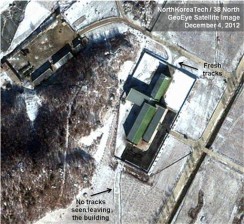Snow may have slowed North Korea launch prep

This Dec. 4, 2012 satellite image taken by GeoEye and annotated and distributed by North Korea Tech and 38 North shows snow covering the Sohae launching station in Tongchang-ri, North Korea, including the path where trailers would be used to move the rocket stages from the assembly building to the launch pad in preparation for a Dec. 10-22 launch. New satellite images show that heavy snowfall may have slowed North Korean rocket launch preparations but that Pyongyang could still be ready for liftoff starting Monday, Dec. 10, 2012. This image was shared with the AP by the 38 North and North Korea Tech websites, which collaborate on analysis of the satellite imagery. AP Photo/GeoEye via North Korea Tech and 38 North. MANDATORY CREDIT
SEOUL, South Korea—New satellite images indicate that snow may have slowed North Korea’s rocket launch preparations, but that Pyongyang could still be ready for liftoff starting Monday.
South Korean media reports this week quoted unnamed officials in Seoul as saying North Korea had mounted all three stages of the Unha rocket on the launch pad by Wednesday. But snow may have prevented Pyongyang from finishing its work, according to the GeoEye satellite images from Tuesday scrutinized by analysts for the websites 38 North and North Korea Tech and shared with The Associated Press.
The analysis and images taken Dec. 4 provide an unusually detailed public look at North Korea’s controversial preparations for a launch that the United Nations, Washington, Seoul and others say is a cover for a test of technology for a missile that could be used to target the United States.
The launch preparations have been magnified as an issue because of their timing: Both Japan and South Korea are gearing up to hold elections this month, and President Barack Obama will be inaugurated for his second term in office in January.
North Korea, for its part, says it has a right to pursue a peaceful space program and will launch a satellite into orbit sometime between Monday and Dec. 22. That launch window comes as North Korea marks the Dec. 17 death of leader Kim Jong Un’s father, Kim Jong Il. North Korea is also celebrating the centennial of the birth of Kim Jong Un’s grandfather, national founder Kim Il Sung.
Images from Dec. 1 showed no activity at the launch pad, but by Tuesday North Koreans were seen working under a dark canvas, according to the analysis by 38 North, the website for the U.S.-Korea Institute at Johns Hopkins School of Advanced International Studies, and the North Korea Tech website, which collaborated with 38 North on the report.
The analysis contradicts South Korean media reports saying the rocket stages were set up by Wednesday, the websites said, because North Korea needed four days to erect a similar rocket before a failed launch attempt in April. Snowfall on Dec. 3 may have temporarily stopped work at the site, according to the analysis written by Nick Hansen, a retired expert in imagery technology with more than 40 years of national intelligence experience.
North Korea has a long history of developing ballistic missiles, but in four attempts since 1998 has not successfully completed the launch of a three-stage rocket. It has also conducted two nuclear tests, intensifying worry over how its rocket technology could be used in the future, particularly if it masters how to attach a nuclear warhead to a missile.
North Korea, however, can still be ready for liftoff Monday, the analysis said.
Based on its preparations for the April launch, which broke apart shortly after the rocket was fired, Pyongyang has to finish stacking its rocket stages only two to three days ahead of time — meaning workers could finish by Saturday and still be ready for a launch on Monday, the analysis said.
North Korea may have chosen a 12-day launch period, which is more than twice as long as the April period, because it was worried about possible weather complications, the analysis said.
“Pyongyang’s rocket scientists can’t be happy about the increased technical risks of a wintertime test, but certainly appear to have taken every precaution necessary in order to launch the rocket on time,” said Joel Wit, a former U.S. State Department official and editor of 38 North.
A rocket can be launched during snowfall, but lightning, strong wind and freezing temperatures could stall a liftoff, said Lee Chang-jin, an aerospace professor at Seoul’s Konkuk University.
North Korea’s launch plan is meant to show the world its capability to build missiles, U.S. Pacific forces commander Adm. Samuel Locklear said Thursday. The United States has moved extra ships with ballistic missile defense capabilities toward the region, officials said.
The U.S., Japan and South Korea say they’ll seek U.N. Security Council action if the launch goes ahead in defiance of existing resolutions. The council condemned April’s launch and ordered seizure of assets of three North Korean state companies linked to financing, exporting and procuring weapons and missile technology.
On Friday, Japanese Prime Minister Yoshihiko Noda visited a Tokyo military facility to inspect Patriot Advanced Capability-3 missile interceptors being readied to intercept a North Korean rocket if it falls on Japanese territory.














